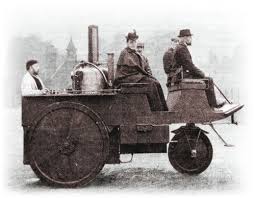
Work on the three-wheeled Grenville Steam Carriage is believed to have begun in 1875, and taken fifteen years to complete. The vehicle was designed by Robert Grenville, assisted by the future Chief Mechanical Engineer of the Great Western Railway, George Jackson Churchward.[a]Churchward took up his post with the Great Western Railway in 1902.[1] Built in Glastonbury, Somerset it was initially powered by a single-cylinder steam engine, later replaced by a side-valve twin-cylinder unit, with a rear-mounted boiler and driven rear wheels. The single front wheel allowed the vehicle to be steered by the use of a tiller. With accommodation for four passengers, the Grenville was capable of a top speed of 18 mph (29 km/h).[1][b]At the time of the vehicle’s development, the Highways and Locomotive ActThe Locomotive Acts of 1861, 1865 and 1878 set the United Kingdom's first speed limits for road-going vehicles; powered passenger vehicles were at the time known as light locomotives, as they were invariably powered by steam. 1878 imposed a national speed limit of 4 mph (6 km/h), and stipulated that a pedestrian must precede the motor vehicle by 20 yards (18 m), to warn other pedestrians and horses of its approach. The Highways and Locomotive Act 1878 had removed the requirement for the pedestrian to be carrying a red flag,[2] but it was not until the passage of the Light Locomotives on Highways Act 1896 that the speed limit was raised to 14 mph (23 km/h).[2]
The Grenville Steam Carriage required two operators: a driver at the front, and a fireman at the rear whose main job was to maintain the water level in the boiler, which was consumed at the rate of 4–5 gallons per mile; 5–6 lbs of coal were also used every mile. The carriage was used in and around Glastonbury for twenty years, before being converted to a stationary engine to power a cider mill. In 1947 it was presented to the Bristol City Museum, who restored it to road-going condition.[3]
The only Grenville Steam Carriage ever built is now in the collection of the National Motor Museum, and is believed to be the oldest self-propelled passenger-carrying road vehicle still in working order.[4]
Notes
| a | Churchward took up his post with the Great Western Railway in 1902.[1] |
|---|---|
| b | At the time of the vehicle’s development, the Highways and Locomotive ActThe Locomotive Acts of 1861, 1865 and 1878 set the United Kingdom's first speed limits for road-going vehicles; powered passenger vehicles were at the time known as light locomotives, as they were invariably powered by steam. 1878 imposed a national speed limit of 4 mph (6 km/h), and stipulated that a pedestrian must precede the motor vehicle by 20 yards (18 m), to warn other pedestrians and horses of its approach. The Highways and Locomotive Act 1878 had removed the requirement for the pedestrian to be carrying a red flag,[2] but it was not until the passage of the Light Locomotives on Highways Act 1896 that the speed limit was raised to 14 mph (23 km/h).[2] |
